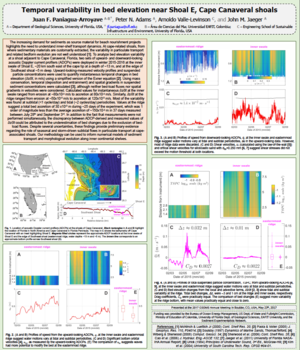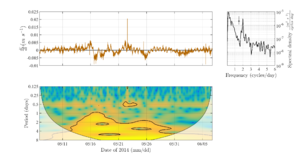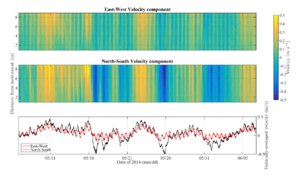Annualmeeting:2017 CSDMS meeting-113
Browse abstracts

The increasing demand for sediments as source material for beach nourishment projects highlights the need to understand inner-shelf transport dynamics. At cape-related shoals, from where sedimentary materials are customarily extracted, the variability in particulate transport and related bedform evolution are not well understood.
To analyze bed elevation variability at a shoal adjacent to Cape Canaveral, Florida, an acoustic Doppler current profiler (ADCP) was deployed in spring 2014 at the outer swale of Shoal E, ~20 km south east of the cape tip at a depth of ~13 m. ADCP-derived velocity profiles and suspended particle concentrations were used to quantify instantaneous temporal changes in bed elevation (dζ/dt) using a simplified version of the Exner equation. Using mass conservation, temporal (deposition and entrainment) and spatial gradients in suspended sediment concentrations were calculated, although neither bed-load fluxes nor spatial gradients in velocities were considered.
Calculated values for instantaneous dζ/dt ranged from erosion at ~1e-3 m/s to accretion at 0.5e-3 m/s. Most of the variability was found at subtidal (<1 cycle/day) and tidal (~2 cycles/day) periodicities. Bed changes were small (<0.005 m/s) when tidal motions were important, e.g. from May 6 to 16, whereas subtidal motions at periods of 1 and 8 days dominated erosion/accretion events between May 16 and 31. Values suggest a bed erosion of 3.1e-3 m during ~30 days of the experiment, which was 2 orders of magnitude less, and had a contrary tendency to the average accretion of ~150e-3 m in 37 days measured between July 28 and September 3 at the edge of Southeast Shoal, i.e. ~5 km to the northwest.
In addition to the fact that measurements were not performed simultaneously at the same location, the discrepancy in dζ/dt could be attributed to the underestimation of bed changes due to the exclusion of bed-load fluxes. Despite several uncertainties, these findings provide preliminary evidence regarding the role of seasonal and storm-driven subtidal flows in particulate transport at cape-associated shoals. Our methodology can be used to inform numerical models of sediment transport and morphological evolution along inner continental shelves.


